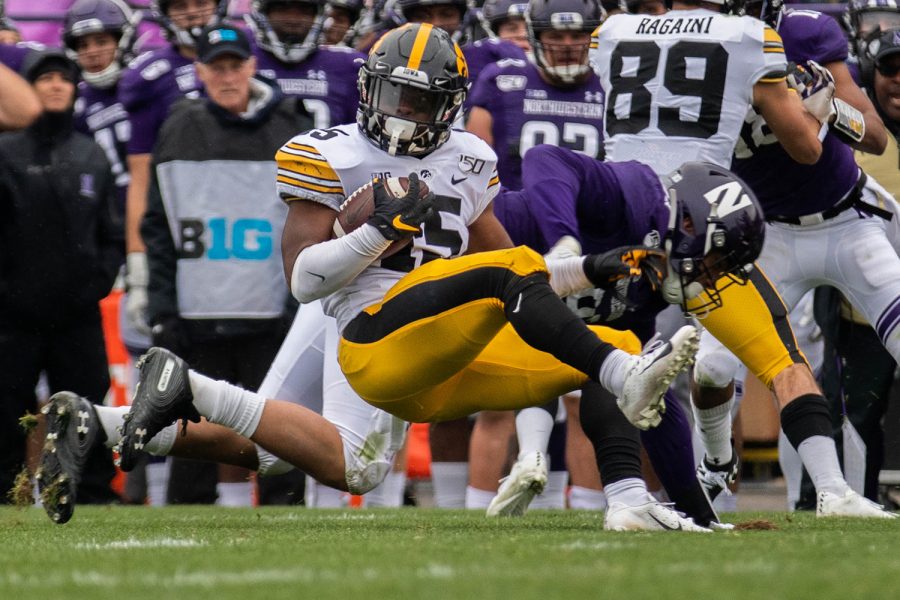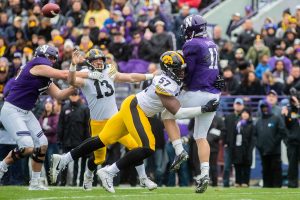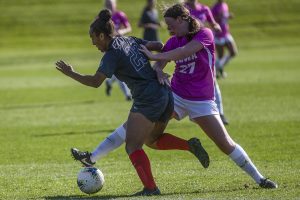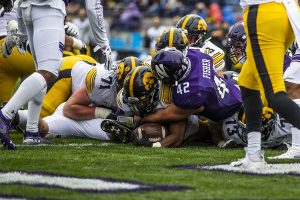Hawkeye rushing attack finally successful against Wildcats
Iowa has a history of struggling in the run game against Northwestern, but that changed in the second half on Saturday.
Iowa running back Tyler Goodson completes a carry during a game against Northwestern at Ryan Field on Saturday, October 26, 2019. The Hawkeyes defeated the Wildcats 20-0.
October 27, 2019
The Iowa running backs produced a strong second-half performance against Northwestern on Oct. 26, ending Hawkeye rushing struggles against the Wildcats.
Facing a Pat Fitzgerald-led Northwestern always means facing a gritty defense, most notably when defending the ground game. Iowa had dropped three-straight matchups against Northwestern heading into Evanston last weekend, and a common thread appeared with each loss: lack of run game. Northwestern held Iowa to under 90 yards on the ground in each of the previous three matchups between the teams, with a measly 64 rushing yards coming from Iowa in 2018.
The first half on Oct. 26 looked to be much of the same. Iowa ran the ball 17 times in the first half, only netting 45 yards and giving the Hawkeyes just over 2.65 yards per carry. Even more, freshman Tyler Goodson — who has been one of Iowa’s three go-to backs so far — didn’t see much action in the first half, only netting two yards on one carry.
But that changed in the third quarter. In Iowa’s first possession after the break, Goodson received 8 touches and rushed for 48 yards, opening the door for both an Iowa touchdown and a solid half for his rushing unit.
“Tyler’s learning what to do, and he doesn’t seem to be overwhelmed out there,” head coach Kirk Ferentz said. “He hasn’t looked out of place at all at any time this season, so we’ll continue using him.”
RELATED: Ruden: Iowa in perfect position ahead of Wisconsin game
Goodson left the drive with an injury, leaving the door open for Mekhi Sargent to finish off the drive with a one-yard touchdown run. Sargent emphasized after the game that the backs are unselfish and that each of them understands the roles needed to win games.
“It doesn’t matter [who gets more touches],” Sargent said. “We feed off one another. When one guy gets in the end zone, the rest of us are excited for that guy, and when our number is called, we go out there and perform to the best of our ability.”
This 59-yard drive out of the half was essential, since the only Iowa points to that point had come from a 50-yard Tyrone Tracy touchdown catch and a Keith Duncan field goal. Iowa hadn’t found ways to move the ball for any significant amount of time.
Iowa’s two opening offensive drives were not promising for the Hawkeye rushing attack. Five pass plays stretched across the first two drives — ending with four incompletions and an 11-yard Northwestern sack of Nate Stanley — and the offense only attempted one rush. The nightmare-like inability to run the ball seen in the past three years against Northwestern seemed to be reviving itself.
But dueling some of the best offensive tackles in the country — Alaric Jackson and Tristan Wirfs — can take a toll on opposing defensive lines. In the second half, Iowa ran the ball 23 times for 78 yards, averaging out to just under 3.4 yards per carry. Wirfs specifically noted the backs’ unrelenting commitment to finding holes and gaining yards on the ground.
“Our running backs, they tend to find holes really well, and they keep plays alive,” Wirfs said. “They’ll bounce off some tackles, so you just have to block to the whistle and keep dragging your feet, because they’re going to pop something.”
All of Iowa’s backs finished the game averaging at least three yards per carry. To no surprise, the weather in Evanston was cold and rainy; when this continues to be the norm in the coming months, Iowa’s commitment to the run will become even more essential.






